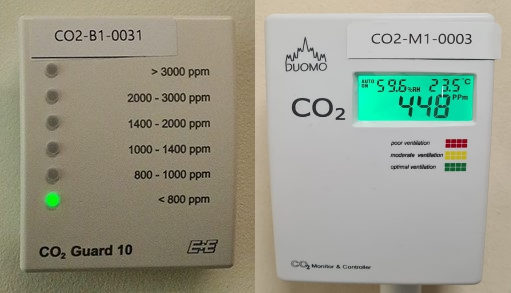All shared teaching and shared workspaces in UCD will continue to be reviewed and assessed by Estates Services as to the type and extent of ventilation present.
Mechanical Ventilation
All mechanical ventilation systems have been serviced and where necessary bearings, fans, filters, etc. have been replaced.
All mechanically ventilated teaching spaces have been assessed for their capacity to provide adequate ventilation in line with REHVA Covid 19 guidance. Systems have been set to run at a higher rate (i.e. introduce more fresh air than usual) for longer periods than would normally be the case, both starting earlier in the day and running for longer periods in the evening where appropriate. Any systems with the potential for air recirculation between spaces have been set up to provide fresh air supply only (i.e. 100% of supply air is drawn from outside of the building).
Any rooms not in compliance with these guidelines have been modified to improve ventilation, have had their capacity reduced or have been removed from use as a classroom. Where the ventilation of spaces has been modified this has been revalidated within the space and where necessary external guidance and advice has been sought.
In some cases the use of HEPA filtered air treatment units may be used in lieu of ventilation in some teaching spaces if an adequate level of filtration can be achieved.
It should be noted that as ventilation rates are increased it is likely that there may be additional noise in rooms.
Faculty will be informed if a teaching space is to be removed from use for maintenance or other reasons and alternative arrangements put in place.
Mechanical ventilation systems have been set up so as to provide an optimum supply of fresh air. This is achieved in one of two ways:
- CO2 sensors within the system monitor CO2 levels in the space and optimise air flow in response to CO2 levels. As CO2 levels rise (indicating higher occupancy) the rate of air supply increases, with the aim to keep CO2 levels below 1,000 parts per million (ppm)
- For those ventilation systems without inbuilt CO2 monitors the supply fans have been programmed to deliver a constant supply 8-10 litres per second of fresh air per person assuming a 100% occupancy rate in the space.
Mechanical ventilation systems are monitored via UCD’s Building Management System. This system allows Estates Services engineers to monitor the operation of ventilation systems to ensure that they are functioning properly.
Natural Ventilation
Natural ventilation depends on the use of windows. Estate Services are continuing to assess naturally ventilated teaching space and shared workspace to ensure that there are openable windows present in every such space and that such windows are working correctly to allow for adequate ventilation.
The adequacy of natural ventilation has been assessed using the 2019 Building Regulations Technical Guidance Document Part F (Ventilation). This technical guidance sets out minimum requirements for naturally ventilated spaces in order to achieve adequate ventilation based on the relationship between window openings and floor space.
